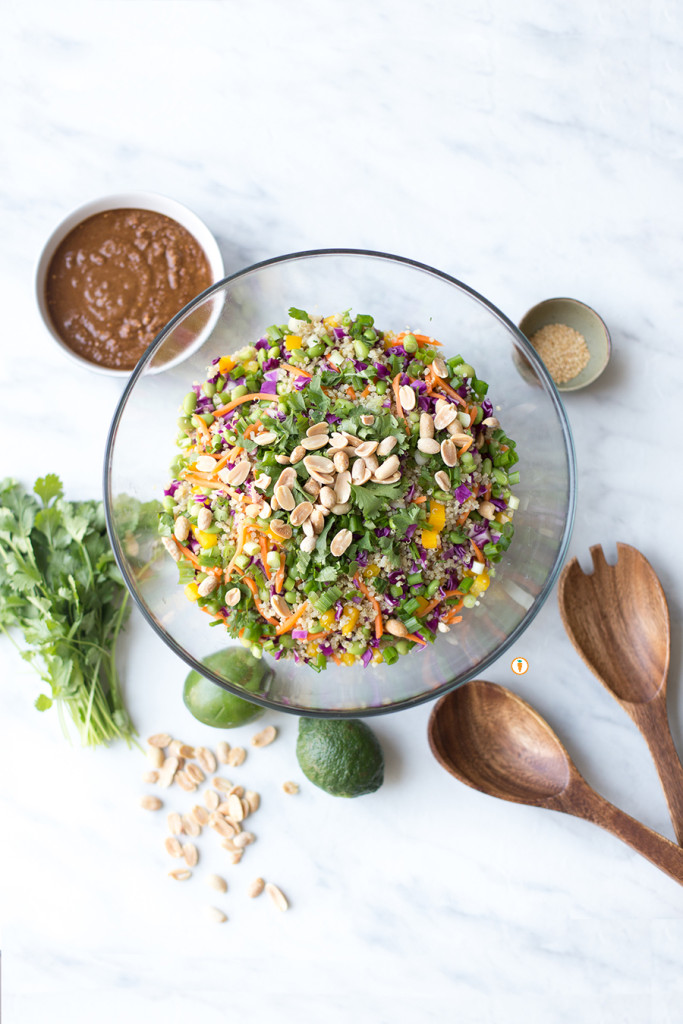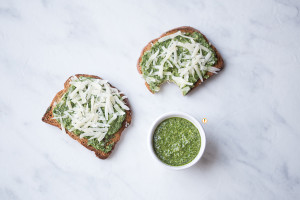We’ve all been there – in a perfect world, we’d be able to whip up a delicious meal from scratch every day. But you and I both know that in reality, ain’t nobody got time for that!
If you’re the type of person who rolls with the punches, that’s totally cool! But if you’re wondering how you can improve your daily eating habits, and the words MEAL PREP freak you out a bit, don’t worry – we’ve got your back! Meal planning does take some time, but it’s not as daunting as you think. Our free printable below is a great way to help you visualize and plan out your meals and tasks for the week.
Here are some tips to help you get going:
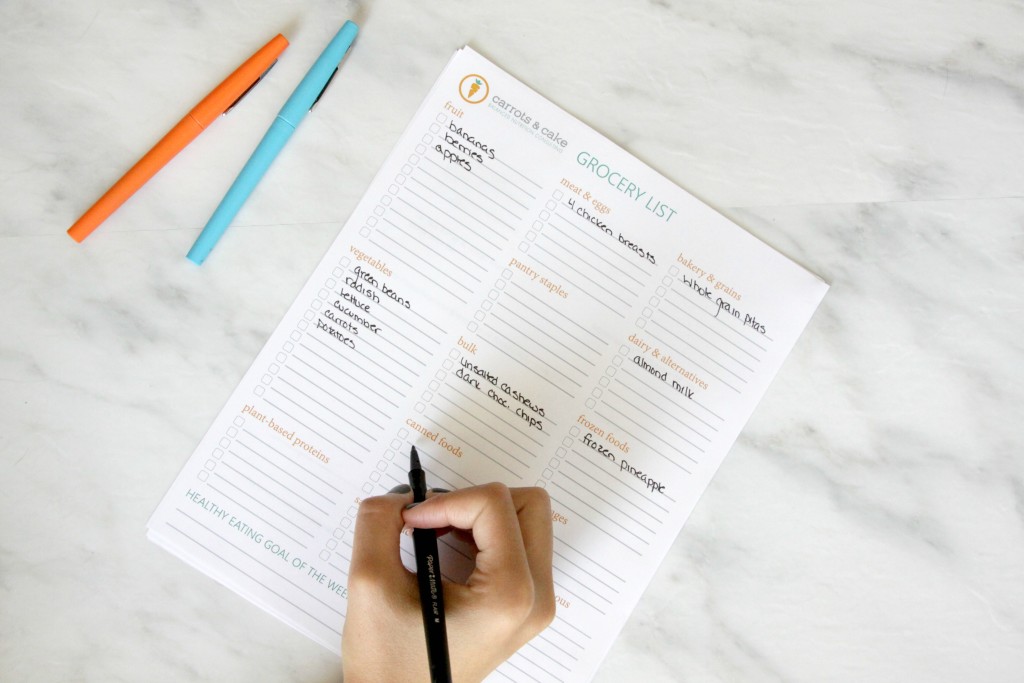
Planning ahead makes CENTS
Save your hard earned dollars – look through flyers (print or online) for the best deals that week – then plan your meals around those ingredients. Some grocery stores now have apps that will show you their special offers for the week. Plan for one meatless meal a week (Check out this economical and tasty mac and cheese recipe.)
Stock Up
Keep your pantry and freezer stocked with basics that will allow you to whip up a quick meal when you’re in a time crunch. This can include whole-grain pasta, rice, lentils and beans, canned fish, and frozen fruit and vegetables.
Cook once, eat later
Make extra portions of the same ingredient that can transformed into something else later – for example, instead of cooking up one chicken breast for dinner, make a couple more and refrigerate for later in the week. It can easily be added to wraps or pasta. Cooked quinoa can be a side dish, tossed into a salad or stir fried. Making extra doesn’t necessarily add time to your prep, and it will save you time down the road.
The freezer is your friend
On that note, you can cook extra, but you don’t have to be eating leftovers all week. Freeze some extra portions, and you’ll thank yourself a couple months down the road when you’re tempted to call up your takeout spot. This hearty meat marinara freezes beautifully – just cook the pasta the day of! You can also portion a few meals individually for your own “microwave meals” to bring to work, or to heat up after a busy day.
Enlist Help
Don’t have much space in the freezer? Grab a friend and cook together! Sharing recipes help to keep things fresh. You can split the cost of groceries and the workload while enjoying each other’s company. This is also a great way to get the kids involved – have them help with washing and prepping produce, and measuring ingredients.
Let Your Appliances Do The Work
You don’t need to stand in front of the stove for hours. Take advantage of time-saving appliances such as a slow cooker, the oven, rice cooker or pressure cooker. Try baking chicken or fish instead of pan-frying – or try this slow cooker recipe for honey ginger chicken)!
Balance, balance, balance
Eat whatever you feel like – really. Don’t stress yourself out trying to plan an entire week’s worth of “clean eats” (What is that anyway? Food is food, people!). Just aim for each meal to consist of ½ veggies, ¼ whole grain or starchy vegetable, and ¼ protein. It’s all good.
Get organized
Figure out days that work best in your schedule for menu planning, grocery shopping, and meal prepping. Keep an ongoing list of recipes you’d like to try (hello pinterest!) and grocery list handy.
Alright, now that we’ve got the basics down pat – use this free printable to help you plan your meals and groceries for the week. Set aside a couple hours one day a week to prepare as much as you can ahead of time – chop up veggies for salads and cooked recipes once and divvy them up as needed. Soups and stews can be easily made ahead of time (and taste better the longer they sit!) You can also get breakfasts done for busy mornings – try these recipes for overnight oats or breakfast muffins.
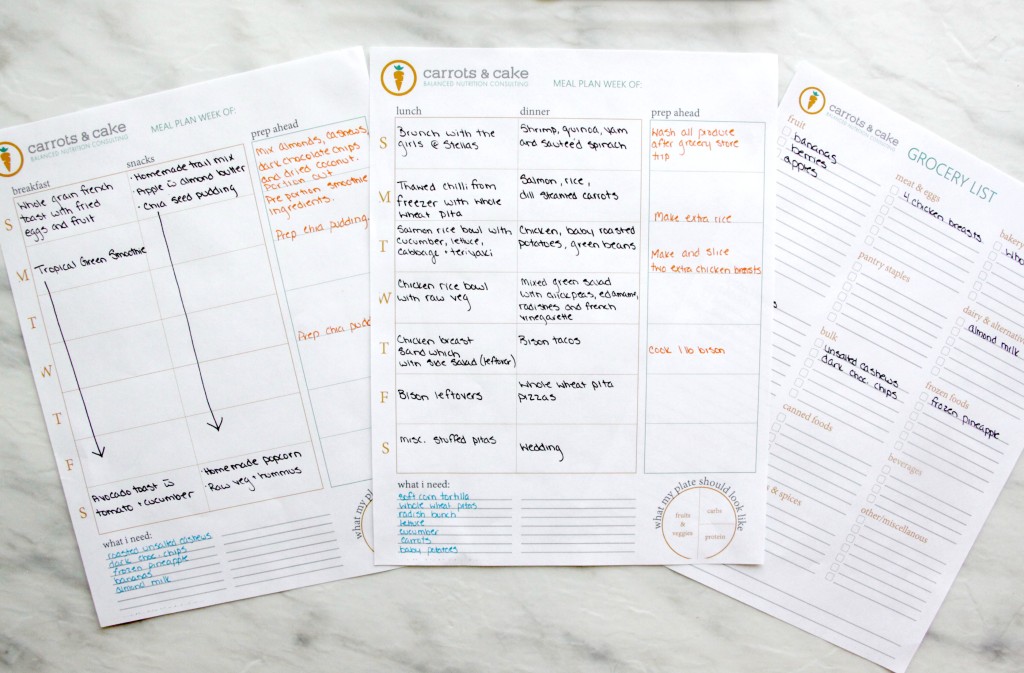
Happy meal planning!
Click here to download meal planning tools:
Photography done by Johanna Adriaansen. To learn more about Johanna click here or follow her on Instagram.
Please note the content of this post was written by Christy Lai, BSc. Human Nutritional Sciences.
Don’t forget to follow Carrots and Cake on Instagram to see tiny square snap shots of my life.
– With Love, Carrots and Cake,

 There has been so much on my mind over the last several months that I’ve been wanting to share. Unlike other posts, this one tugs a little deeper into my heart, because well, things have changed. I have changed. I’m Jaidev’s mom now, and that my friends is a game changer, kay?
There has been so much on my mind over the last several months that I’ve been wanting to share. Unlike other posts, this one tugs a little deeper into my heart, because well, things have changed. I have changed. I’m Jaidev’s mom now, and that my friends is a game changer, kay?
While I don’t quite know where to start, I’m going to start with this bold and matter-of-fact statement:
breastfeeding is f*cking hard.
Wow, that felt liberating.
During my months of carrying a gorgeous belly I heard countless stories from women who shared their birthing experience with me. And then when it came down to show-time, I brought it on. My birth was beautiful, I felt powerful, strong and none of it ever felt impossible. I also heard a lot of comments about sleepless nights, babies that cry non-stop and bodies that were left broken post-delivery. I heard it all (and appreciated it). But during those nine months that I carried Jaidev no one ever spoke to me about how challenging breastfeeding was going to be.
I’m a Registered Dietitian by profession but also a high-achiever by nature. I set out with the intention of breastfeeding my baby but I always remained open to the idea of having to offer my babe formula if necessary. Because sometimes, breastfeeding just doesn’t work the way the textbook says it will.
When Jaidev was born, he was immediately placed on my chest. His cries were like music to my ears. I remember slowly motioning him towards my breast and I expected him to magically open his mouth nice and wide, clench and start sucking. That did not happen. Instead my tiny and tired baby cried at my breast and it took him a long, long, long time to latch. After three days in the hospital and two visits from a lactation consultant we were sent home with bottles of formula, instructions to offer finger feeds with pumped milk and/or formula and a suggestion to purchase a nipple shield. We did all of that.
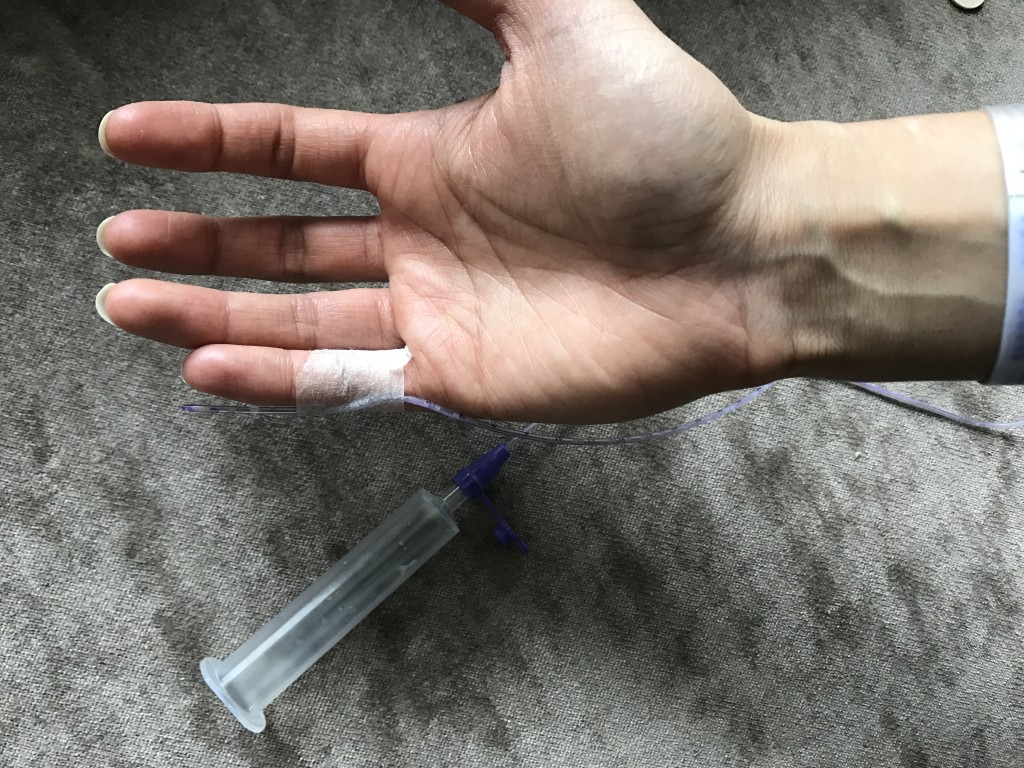
This is what’s involved with finger feeding. I would pour pumped milk/formula into the syringe and then Jai would suck on my finger to retrieve his feeding. This taught Jaidev to “suck” but was a lot of work for mummy.
I remember being at home – pumping breastmilk to stimulate production, finger feeding formula to encourage Jaidev to suck and then having him on my breast using a nipple shield to maintain skin-to-skin contact. That was a lot to focus on and as the days progressed I was starting to worry that breastfeeding wasn’t going to be in my deck of cards. Thankfully, a visit from our local Public Health Nurse helped to calm my nerves and rebuild the confidence I needed to trust my body. My next instruction was to stop finger feeding, give the pumping a break and focus on Jaidev sucking on my breast using the nipple shield. I kept all of that in mind.
The next several days were a mixture of magic and pain. Jaidev did so well using the nipple shield, I was so proud of my little guy. But then the cluster feeding started. NO ONE EVER TOLD ME ABOUT CLUSTER FEEDING. If post-birth recovery wasn’t already challenging, cluster feeding really f*cked shit up. Cluster feeding is when newborns space feedings closer together at certain times of the day. It’s also known as “bunch feeding”. After being 5 days old, Jaidev cluster fed every. single. night. for two to three hours. This lasted for almost three month and during those hours he wasn’t a very happy baby.
Initially, I was convinced my child was missing his biological hunger/fullness cues. Those hours of cluster feeding would typically take place late at night when the rest of the house was asleep. That time with Jaidev was really memorable and very special for us; it was just me and him but it was also extremely challenging. I was exhausted, my back was in pain, my pelvic muscles were healing, my nipples were raw and sleep was non-existent.
During the cluster feeds my baby would cry and cry at my breast for milk. I didn’t get it. How could he be so calm at my chest one minute and then so upset? Was this going to last forever? How was I going to survive? It felt like I was in a tunnel with no end in sight. I worried he was somehow starving (he wasn’t) and would offer ad lib formula through a bottle. The bottles of formula would help settle Jaidev but I also knew that if I was going to offer top up every night, I was going to risk not giving my breasts an opportunity to build a proper supply.
My goal was to exclusively breastfeed my child. I decided that in order to stay motivated I needed to see the end from the beginning; if I wanted breastfeeding to work for us then I needed to give it a fair shot before deciding to throw in the towel. I worked on small goals – trying to get through day by day. And then week by week. And now month by month.
I relied heavily on my tribe of women for support. My sister, friends and colleagues were all sideline cheerleaders encouraging me to do what felt right. There were women who completely formula fed, others who exclusively pumped, exclusively breastfed and some who did a mixture of it all – each of them reminded me to stay strong, confident and to check-in with my own emotional and mental wellbeing.
Fast forward five months: Jaidev and I have an amazing breastfeeding relationship. In my experience, we couldn’t have been successful at maintaining this relationship without the nipple shield. It was our saving grace. I worried Jaidev would always need the shield or that he wouldn’t reap the full benefits of breastfeeding with it, but I was wrong. Around the time he turned four months he was able to latch directly on my breast. I still remember that exact moment when he latched directly onto my nipple, my eyes welled up with tears, I whispered “we did it” and called my husband over to witness the magic. I was ecstatic that I wouldn’t have to rely on the nipple shield anymore.
It’s interesting how life works. I spent weeks feeling almost burdened by breastfeeding and now I’m saddened by the thought of him weaning. Apart from being able to supply my child with antibodies, anti-allergens, growth factors and anti-viruses via breastfeeding, I’m going mostly miss the way he holds my hand, his smiles when he takes a break f or the way he looks so peaceful in my arms. I’ll be sad when this happens, but I’ll let Jaidev take the lead and follow along.
What’s the point here? I wanted to communicate the challenges of breastfeeding that often get over shadowed by the enormous work of delivery. I want to share my experience in hopes that perhaps someone out there can be better prepared or perhaps someone else can relate. It comes as no surprise, I’m an advocate for breastfeeding, but always remember this:
Breastfeeding does not trump a mothers mental health.
If you’re feeling challenged by breastfeeding, need a confidence boost or even some support – go get it. And if it’s not working, then that is okay. There are other options available to help you nourish your baby so that you can work on being the super mama that you are.
Don’t forget to follow Carrots and Cake on Instagram to see tiny square snap shots of my life.
– With Love, Carrots and Cake,

Luckily, I’ve got my hands on a stellar and oober ambitious nutrition student, Johanna, who was willing to put together some information on heart health. AND, this post couldn’t be shared at a better time because as we all know, February is heart month. And shit, well, today was my last opportunity to sneak in a post before we bid farewell to this month! *insert nervous laughter*
Your heart is an important organ. It works steadfast to help you do the things you love and despite all we know about wellness, cardio vascular disease (CVD) is the number one cause of death globally1. That means that more people die from heart failure in some way shape or form than any other cause. Further, about 1.6 million Canadians are currently living with heart disease2. And it’s not just the old people. It’s middle aged smokers, over-weight teens and those of us who don’t make physical activity a priority. I bet you can think of someone in your family who has heart disease or has had a stroke.
CVD affects everyone.
Food.
Unfortunately there is sometimes a myth that fat and sodium are the main culprits of heart disease and sugar get written off. Realistically overconsumption of any of these can contribute to heart disease but lets talk about sugar, specifically free sugar. Free sugar is basically sugars that are added to foods. Ones that didn’t pre-exist. This is where fruits, grains, vegetables etc. get off the hook, phew! On the other hand, free sugars look like this “maple syrup, honey, brown sugar, sugar, agave, molasses, coconut sugar”, and it’s incredibly important to moderate our intake of these because they are loaded with calories that don’t offer much in the way of nutrition. So, without becoming a MyFitnessPal addict a good rule of thumb is that if any free sugars fall within the first 3 ingredients of a food you should probably reconsider.
Intersted in a few heart healthy recipes? Scope out these ideas:
Lifestyle.
Omega-3s.
You’re probably sick of hearing of what you should stop doing at this point. Stop sitting around, stop eating processed foods. So what if we added something in instead? Consumption of Omega-3 fatty acids from fish has been associated with a lower risk of coronary heart disease3. Those Mediterranean folks have really healthy hearts! All that means is that is it important to get in those 2-3 servings of fish weekly!* Even if you live smack dab in the middle of the prairies like me. Also, try a high quality fish oil supplement. *Flashbacks of Mom spooning cod oil into my mouth* #bleh. I’ll take a capsule thank-you very much.
The high numbers of heart disease do not have to predict your health, even if your Grandpa, Great Uncle and childhood cat have been affected. Prevention is the most powerful thing when it comes to noncommunicable diseases such as CVD. Take care of your body and it will love you back for many many many years to come.
* (Pregnant women should consult a doctor to help determine which fish is best for them).
Hu FB, Bronner L, Willett WC, et al. Fish and Omega-3 Fatty Acid Intake and Risk of Coronary Heart Disease in Women. JAMA. 2002;287(14):1815-1821. doi:10.1001/jama.287.14.1815.
Please note the content of this post was written by 4th year Human Nutritional Sciences student Johanna Adriaansen. Johanna also maintains her own website and is an aspiring Dietitian!
Don’t forget to follow Carrots and Cake on Instagram to see tiny square snap shots of my life.
– With Love, Carrots and Cake,

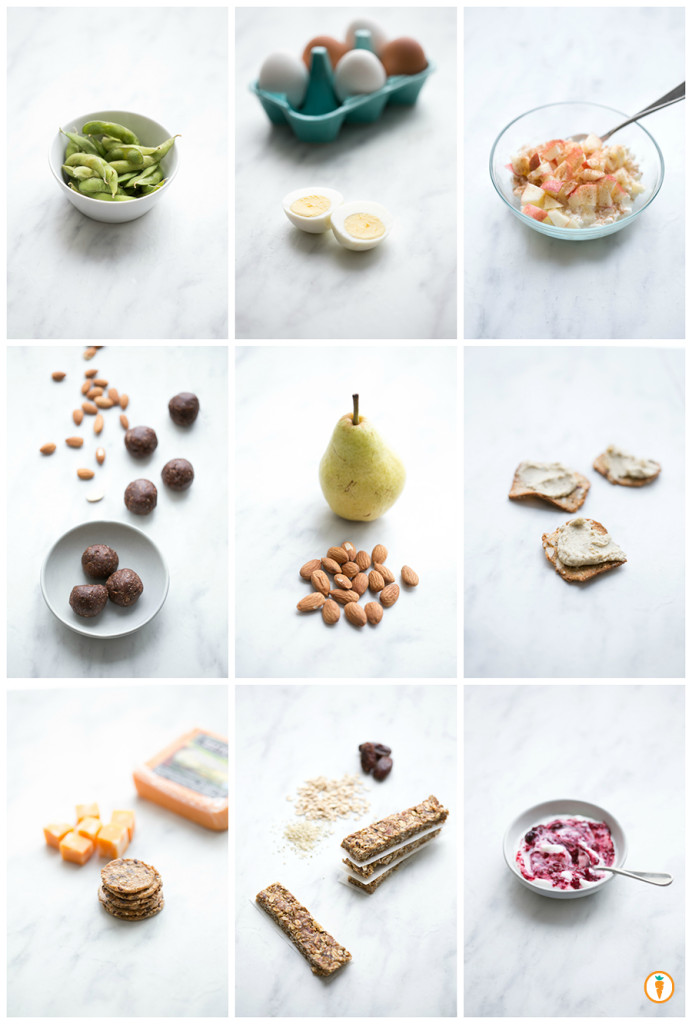
Snack ideas galore!
How (and what) we eat has changed. As a nation we are shifting from 3 meals a day to multiple small meals, or 3 meals and 3 snacks. Back in the day our grandmas didn’t have time to make more than three meals since they were all from scratch, and our grandpas didn’t have time to eat more than 3 meals because they worked sun-up to sun down.
Now, with working households, evolving research and a shift in the eating paradigm our days are certainly not what they once were. A day in the office might look like this; coffee, emails, yogurt, conference call, donut, coffee, emails, lunch, meetings, granola bar, dinner, TV, snacks, social media, bed. Repeat.
Sound familiar? Vaguely?
There is no problem with eating 6 smaller meals a day. In fact about 16% of Canadians are doing it1. Societal demands persuade us to work faster and longer. Time for meals has fallen to the wayside and we are all guilty of eating in the car or eating while scrolling through instagram. However, snacking may be adding calories that we would not have eaten had we stuck to 3 smaller meals. Many snacks nowadays also include a nutrient-lacking drink. A juice box, iced tea or a fancy latte etc. It doesn’t sound too harmful until we look at the 200+ extra calories we are (quickly) ingesting. Not to mention, when we dissect where these calories come from, they often aren’t nourishing. Pair one of these beverages with 200 calories of food and you have a 400 hundred calorie snack meal. Oops.
In order to stop this from happening we need to be mindful of consumption and ensure that we are getting all the nutrients we need from our combination of meals and snacks.
Here’s a bit more guidance:
One.
Just because it says snack or snack pack or snak pax or however the kids are spelling it these days doesn’t mean that it is healthy. Those granola bars and gummy packs are sugar laden regardless if they are made with “real fruit juice” or not. Solution? Homemade granola bars, and a small container of berries or grapes for a sweet bite with the added fibre of natural fruit.
Two.
Just like chocolate bars and ice cream, chips, muffins and cookies are treats. Now there’s nothing wrong with a homemade carrot muffin or a nutrient dense oatmeal cookie in you or your little one’s lunch. But recognize this is a “dessert” or a “treat”.
Fun fact – Tim Horton’s muffins have, on average, 100 more calories than their donuts. Yikes. Maybe we should start calling them cupcakes.
Three.
Include multiple food groups. Aim for 2-3 food groups per snack! It’s important to include a protein and carbohydrate. Benefits of this strategic pairing includes increased alertness, stable sugars and sustained energy. Some examples include cheese & grapes, or nuts with an apple, chicken & cherry tomatoes with a little balsamic vinegar, raw veggies with hummus, banana with almond butter, cottage cheese with black pepper and baby carrots, the list goes on!
Four.
You don’t neeeed to have snacks. As much fun as “eating-cause-I’m-bored” is…it definitely isn’t necessary. Listen to your body and eat when you experience real hunger cues. Start by drinking a cup of water, then if your body demands it, go ahead! Get nourished!
Remember, just like a meal is for nourishment, so are your snacks. You might need a little power in the mid afternoon to get you through the rest of your workday. So make it count. Give your body what it needs. A donut will result in a sugar crash, a handful of almonds and berries will give you human super powers to have the most productive 2-4pm you’ve had all week. Or something like that…
Now, in case you’re interested pictured above are the top 9 snacks I tend to rotate between (from left to right):
- steamed edamame beans
- a hardboiled egg
- cottage cheese with apple and cinnamon
- energy date balls
- pear with a handful of almonds
- crackers with white bean spread
- cheddar cheese with Mary’s Gone crackers
- no bake granola bars
- plain Greek yogurt with 5 ingredient berry sauce
Food photography done by the talented Ceone Dyck. To learn more about Ceone click here or follow her on Facebook.
Please note the content of this post was written by 4th year Human Nutritional Sciences student Johanna Adriaansen. Johanna also maintains her own website and is an aspiring Dietitian!
Don’t forget to follow Carrots and Cake on Instagram to see tiny square snap shots of my life.
– With Love, Carrots and Cake,

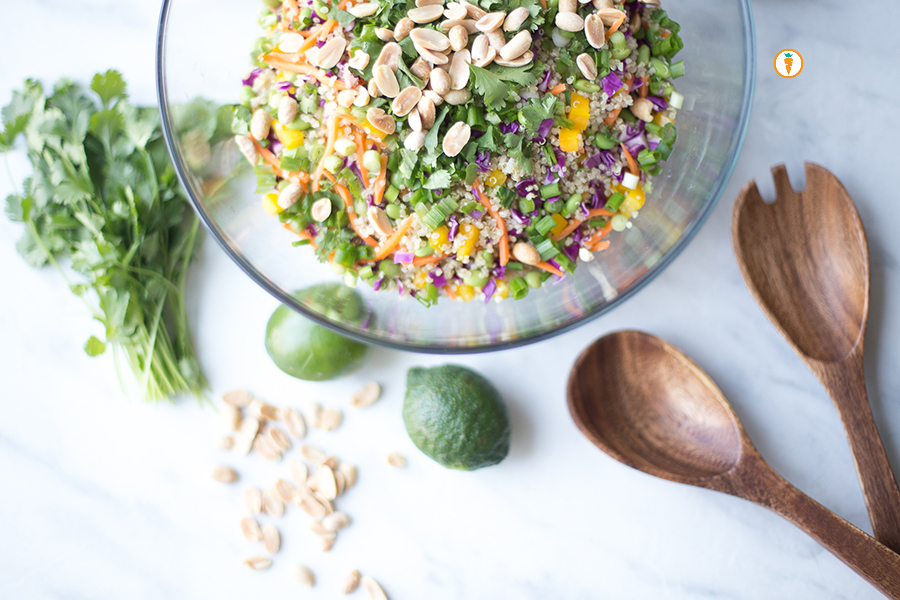 I love quinoa. But I’m really not a fan of it by itself. Are you? My preference is to enjoy it when it’s “mixed” into something like a pesto quinoa salad or as a pilaf with garlic mushrooms. Mmmmm. I’ve been making this version of a Thai quinoa salad for years now but never really took the time to standardize the recipe. With some encouragement from friends and family, I finally did it.
I love quinoa. But I’m really not a fan of it by itself. Are you? My preference is to enjoy it when it’s “mixed” into something like a pesto quinoa salad or as a pilaf with garlic mushrooms. Mmmmm. I’ve been making this version of a Thai quinoa salad for years now but never really took the time to standardize the recipe. With some encouragement from friends and family, I finally did it.
Here are my pre-requisites for a quinoa salad:
I want it to be hearty enough to be a meal, so I need a solid source of protein. Enter the edamame bean! A ½ cup serving of edamame beans is about 12 grams of protein.
I want color. I eat with my eyes so against the quinoa I wanted to see some yellow, red, purple and green. A colorful meal also means I’m feeding my body variety of nutrients.
I want a good-for-you dressing. I’m not fearful of fat and my mantra has always been: it’s not the quantity of fat you eat, it’s the quality. The dressing for this recipe is largely based on peanut butter. Go for a natural PB that isn’t loaded with added fats, sugar or salt. The dressing also has lovely hints of ginger which is great for digestion and amping up the flavor of this salad.
I want it to still be good the next day. C’mon, we all know many salads don’t hold up more than 24 hours. Not this recipe! I prefer to keep the dressing on the side and pour on more as I need it. The quinoa salad itself stays perfectly fine for 3 – 4 days when kept refrigerated in an air-tight container.
This recipe is a hit, no matter where I go. My vegan and vegetarian friends and mama’s all LOVE it. It’s perfect for weekday lunches, as a side or for sharing at a potluck.
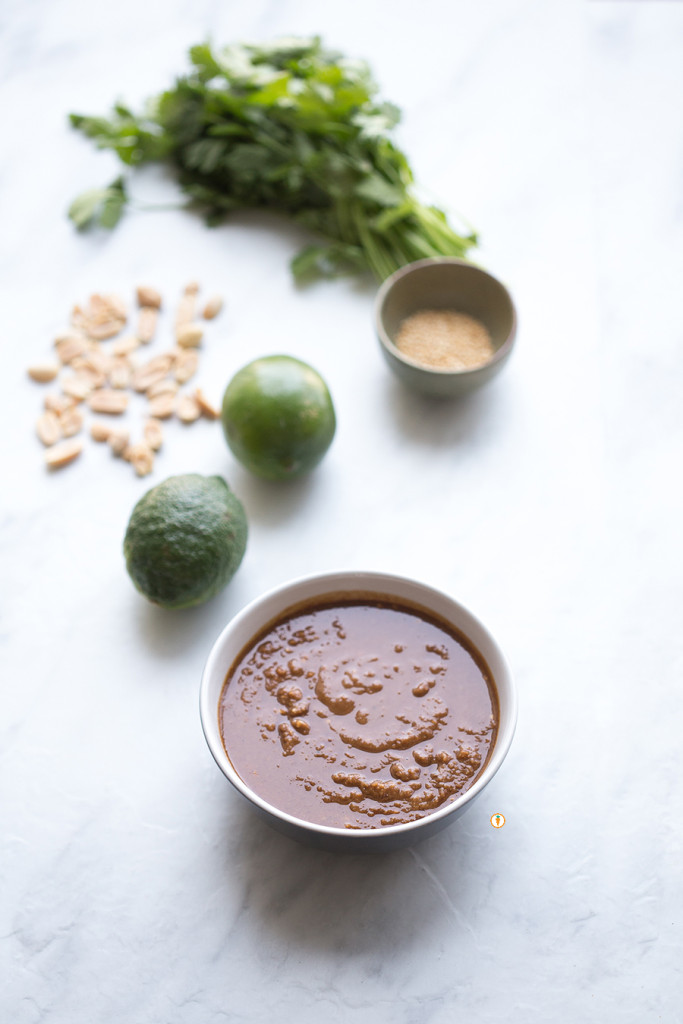
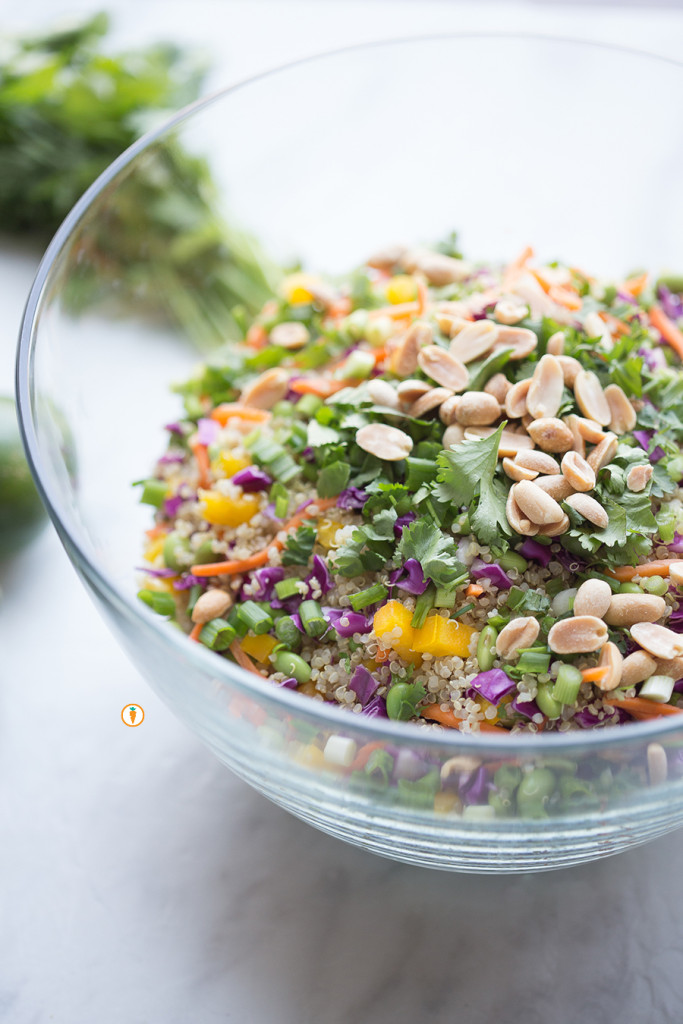
Okay, okay, recipe below!
- Salad:
- 1 cup uncooked quinoa
- 2 cups shredded red cabbage (we like to chop it pretty small)
- 1 red, orange or yellow bell pepper, diced
- 1 cup shredded carrots
- 2 cups edamame beans *steam/cook ahead of time
- ½ cup chopped cilantro
- ½ cup cashews
- 3 green onions, chopped
- For the dressing:
- ⅓ cup natural peanut butter
- 1 tbsp freshly grated ginger
- 3 tablespoons soy sauce
- 1 tablespoon honey (use agave if vegan)
- 3 tablespoons red wine vinegar
- 2 teaspoons sesame oil
- 2 tsp sesame seeds *optional
- juice of one lime
- Prepare quinoa: ensure you've thoroughly rinsed and strained it. Place quinoa in a small pot with 2 cups of water. Bring to a boil and reduce heat to low, cover and simmer until tender and the liquid has been absorbed. About 15 - 20 minutes. Fluff with a fork. Set aside and cool.
- To the quinoa add in cabbage, bell pepper, carrots and edamame beans. Fold this into the the quinoa.
- Prepare the dressing by mixing together all eight ingredients. I often use a handheld blender to do this job but you could totally use your muscles and a strong fork.
- Garnish with cashews, cilantro and green onion. Serve chilled (or eat it up right away).
Food photography done by the talented Ceone Dyck. To learn more about Ceone click here or follow her on Facebook.
Don’t forget to follow Carrots and Cake on Instagram to see tiny square snap shots of my life.
– With Love, Carrots and Cake,

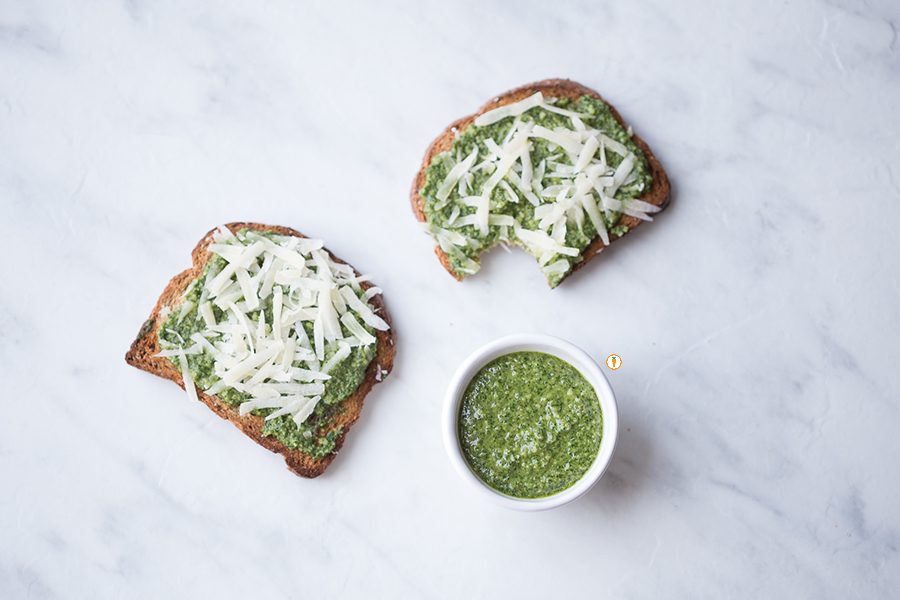 I love me some pesto. Do you? I only began experimenting with this sauce a few years ago and now it’s a pantry staple. Better yet, I’ve even ventured into making my own version of pesto. I was inspired to use kale in this recipe by my summer CSA. We’ve been getting an abundance of kale and I’ve been experimenting with unique ways to use up this nutrient-loaded green.
I love me some pesto. Do you? I only began experimenting with this sauce a few years ago and now it’s a pantry staple. Better yet, I’ve even ventured into making my own version of pesto. I was inspired to use kale in this recipe by my summer CSA. We’ve been getting an abundance of kale and I’ve been experimenting with unique ways to use up this nutrient-loaded green.
Most pesto recipes call for basil. I opted not to use basil primarily because in the fall/winter months it’s actually quite pricey (at least here in Winnipeg) and sometimes I find myself visiting 2 – 3 grocery stores only to not find any! So instead I use parsley. Problem solved.
There’s also a TON of ways you can use up pesto. Here’s a few suggestions to inspire you:
- Use it as marinade for your white fish or chicken
- Place it on top of toast to change up your breakfast game, top with a poached egg
- Toss it in pasta (hot or cold)
- Make pesto spinach muffins
- Use pesto instead of pizza sauce on your crust (my favvv)
- Use pesto for this quinoa salad recipe
- Flavor turkey meatballs with with pesto
- Add small dollops to crostinis and top with cherry tomatoes for a fun appie
- Make a gourmet grilled cheese sandwich with pesto and mozzarella
- Marinade veggies like tomato, zucchini and muchrooms in pesto and grill
Or, eat it by the spoonful
There you have it! Ten ways you can enjoy this pesto!
Why is this pesto a great choice?
- It’s loaded with anti-inflammatory olive oil
- Helps you meet your recommended intake for greens
- Walnuts offer up omega-3, hello heart health!
- There’s cheese in it
- Mic drop, enough said!
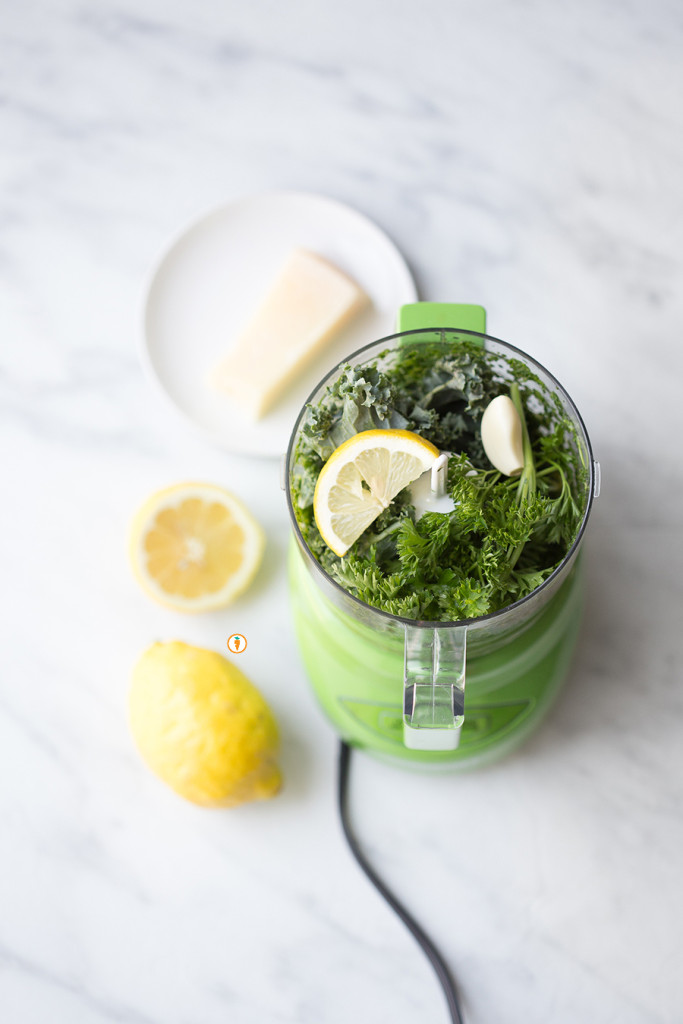
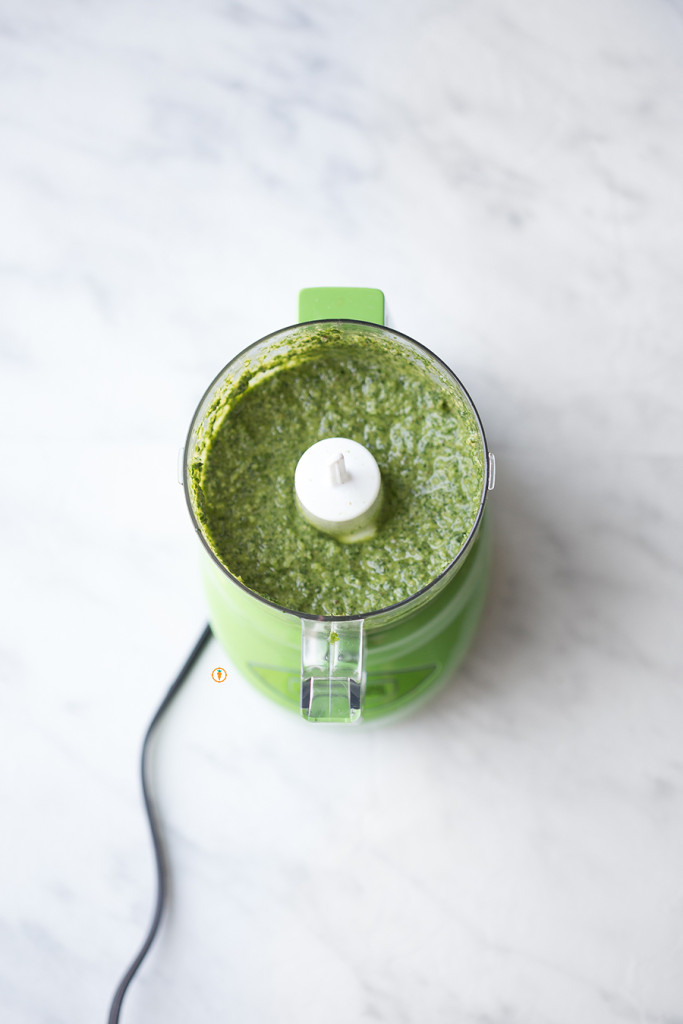
Okay, recipe below.
- ¼ cup walnuts, toasted (or preferred nut)
- 1½ cups torn kale, stem removed
- ½ cup curly parsley, roughly chopped
- ¼ cup cubed or grated parmesan
- ½ cup olive oil
- 1 clove garlic
- juice of one lemon
- To toast walnuts, warm a non-stick skillet over medium heat. Add walnuts and lightly toast for about 8 - 10 minutes or until fragrant. Be careful! You don't want them to burn.
- In a small food processor of blender add walnuts and remaining ingredients. Blend well.
- Taste. Add salt, pepper or more lemon juice as needed. If you find your pesto too runny, you can add another ¼ cup of walnuts.
- Store in an air tight container in the fridge for up to one week or freeze!.
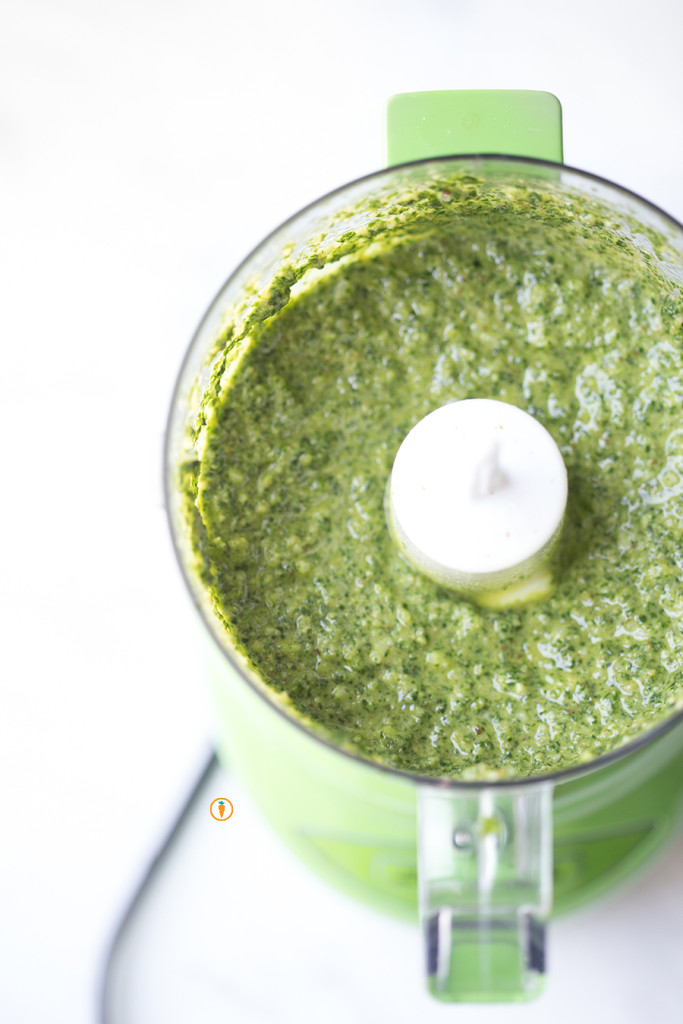 Food photography done by the talented Ceone Dyck. To learn more about Ceone click here or follow her on Facebook.
Food photography done by the talented Ceone Dyck. To learn more about Ceone click here or follow her on Facebook.
Don’t forget to follow Carrots and Cake on Instagram to see tiny square snap shots of my life.
– With Love, Carrots and Cake,

]]>
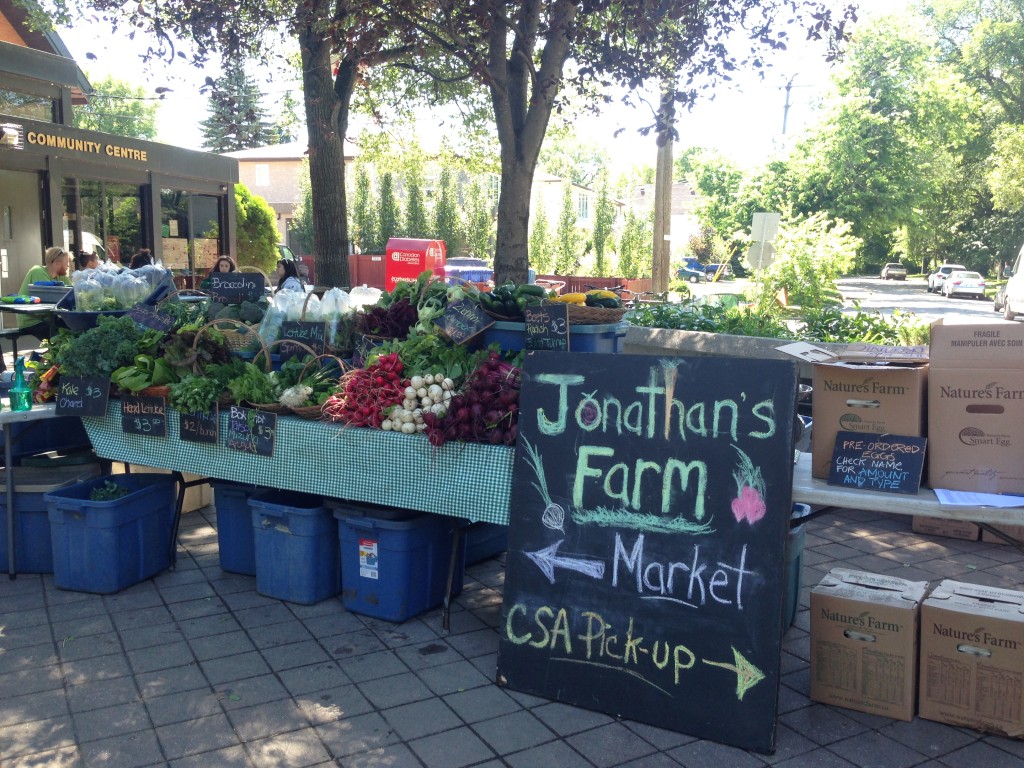
My weekly pick-up stop!
WORD OF THE DAY: lo·ca·vore
Ever heard of the word locavore? A dictionary will tell you that it’s used to describe a person interested in eating food that is locally produced and not moved long distances to market. One common – but not universal – definition of “local” food is food grown within 100 miles (160 km) of its point of purchase or consumption.
So what is CSA and what does it have to do with locavores?
CSA.. Hmm what does that stand for? Maybe you have an idea. It’s something about a farmer sending you a box of fresh veggies right? Oh maaaybe it stands for Canadian Shared Agriculture?! Close, but not quite. Turns out it stands for Community Supported Agriculture and it’s an internationally recognized concept! I’ve been quite curious about the whole scene for some time now but I am finally making a commitment and getting involved! Here’s my story on how it all went down:
Phase 1: Do the research
There is a ton of great information on CSAManitoba.org
CSA Manitoba recommends you ask a couple of key questions before you sign up. Here are a few that I wouldn’t have thought of myself;
- Do you provide recipes for less common produce? Some provide a weekly newsletter and recipes to help you make use of those veggies you may not have come across before (like, kohlrabi!)!
- Is the payment in full or split?
- May I visit the farm during the season?
The website has a very good FAQ page for other questions as well. I browsed the entire website and after a solid look I came to some conclusions.
Pros of a CSA box:
- It’s like a subscription to fruit and vegetables. That is sure to make you way healthier than Cosmo.
- Meeting farmers! Farmer’s feed the world, I’m sure they make great friends.
- The produce is usually picked the same day you receive it! This is a huge advantage as much of the produce we get in Canada travels far and wide. When fruits and vegetables have to travel from Florida, California or Mexico they are picked under-ripe so that by the time they reach our grocery stores they are perfectly ripe. Makes enough sense but that means that the produce is ripening in a dark cool crate instead of being in the sun, attached to plant where it can continue to receive nutrients.
- Strengthening the local economy. After all, you decide with your dollar.
- I’m also looking forward to being challenged by new produce, which I would most likely avoid in the store. Maybe I’ll get a fennel…or is it just fennel? What’s two fennel? Fennels? Feni?!
Cons of a CSA box:
- I can’t see any yet, I’ll keep you posted once the goods start rolling in.
Phase 2: Chose a farm.
CSAManitoba.org is also your go-to for this step.
Out of the 23 farms listed who offer the CSA program I decided on Jonathan’s Farm. Not only did I choose them because the drop off point is very close to my home but also because they farm according to organic standards and aim for sustainable Earth friendly agriculture. Now, I’m not 100% adamant on organic all the time, because I doe have bills to pay. But if I can grab a big box of organic veggies bi-weekly then I am not complaining. Plus Jonathan is an incredibly personable name so I already know he is a good guy.
Here are a couple of things that happen on Jonathan’s farm which contribute to sustainability of the land;
- Cover cropping; No, not like a green house where you cover up the crops, also not a crop blanket made by the crop’s grandma. Cover cropping is when the crops act as a blanket for the land. Which keeps the top soil from blowing away and wasting nutrients.
- Nutrient monitoring; A soil test which determines the amount of minerals and nutrients in the soil and allows the farmer to determine how to best supplement their fields.
- Crop rotation; Planting different crops on the same land each season. Different crops give and take different minerals from the soil. Changing from potatoes to wheat or barley to canola allows the earth to essentially be recycled over and over instead of depleted.
Okay, I think I’ve shared what I wanted for now. If this has peaked your interest, you can always visit Jonathan at the Wolsley Farmers’ Market on Tuesday’s from 3:30pm to 7:00pm at 980 Palmerston Ave. Stay tuned for a follow up post on my experience with my first CSA box this summer. Can’t wait!
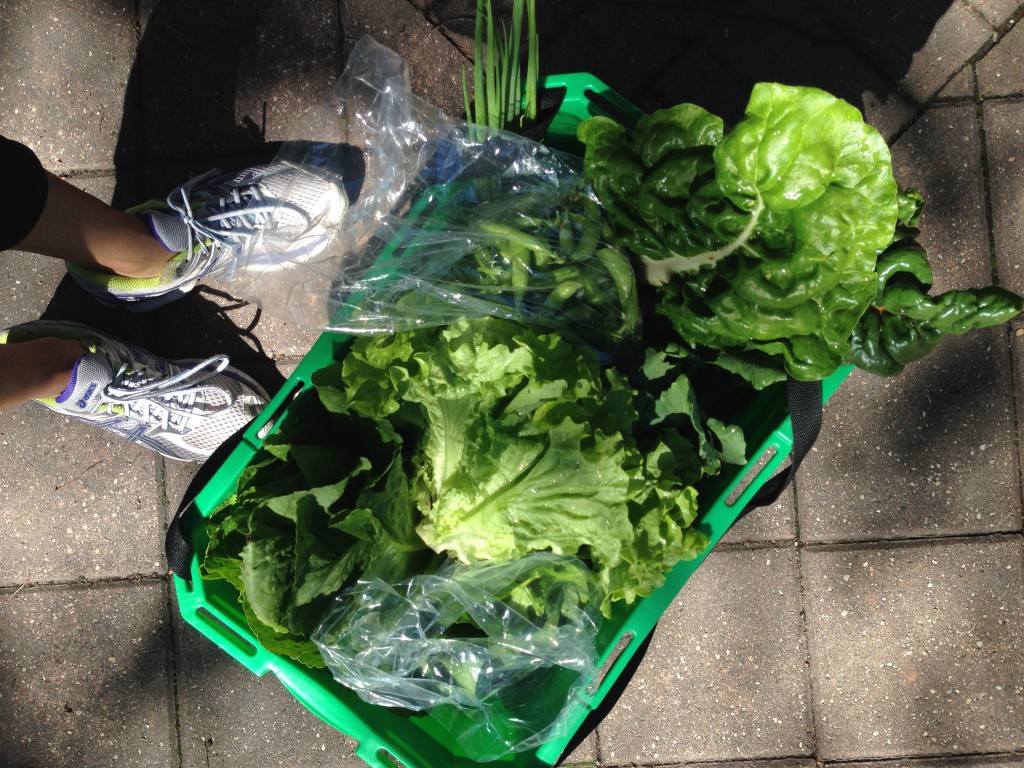
My loot from a few weeks ago: green leaf lettuce, romaine lettuce, peas, spinach, swiss chard, turnips, scallions, radishes, basil + more!
Please note the content of this post was written by 4th year Human Nutritional Sciences student Johanna Adriaansen. Johanna also maintains her own website and is an aspiring Dietitian!
Don’t forget to follow Carrots and Cake on Instagram to see tiny square snap shots of my life.
– With Love, Carrots and Cake,

]]>

Maybe I’m pretending to smile. Or maybe I’m not.  Photo credit: Bree-Ann Merritt Photography
Photo credit: Bree-Ann Merritt Photography
It’s that time of year: the sun is shining, birds are singing, winter jackets are swapped for tank-tops, and parks are filled with ambitious vitamin D deprived Manitobans intent on soaking up every single bit of fresh summer air they can. It’s the absolute best time for outdoor workouts, trips to the zoo, or a hike with friends! But before you grab your runners, rollerblades, or dumbbells, let’s talk about how you can fuel your body to get the most out of your physical activity.
What should I eat before my activity?
The best way to ensure that you’ll be properly fueled for your next sweat session is to eat balanced meals from all four food groups every 3 – 4 hours beginning with a protein and fiber-rich breakfast (like a delicious bowl of overnight oats…see photo below *drool*).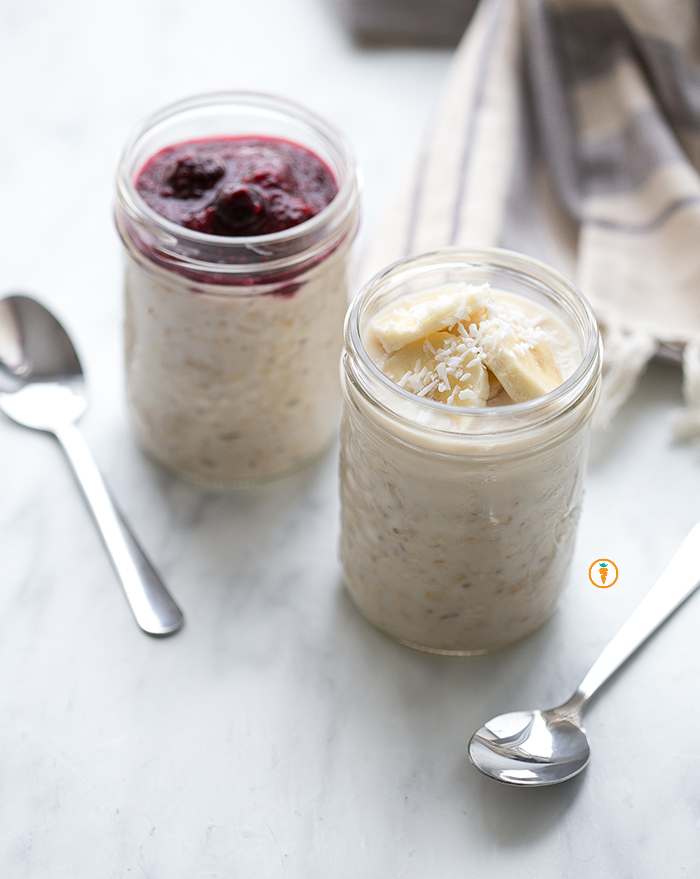
What you choose to eat should ideally be determined by the timing of your workout. For example, if you had a meal at 1:00pm and plan to work out at 3:00pm, there may not be a need for a snack. If there is a longer gap you could consider the following:
2-3 hours prior to exercising, eat something that is sort of like a small meal, aiming for three food groups, and going easy on the fibre and fat (both are known to slow down digestion):
- Chicken breast, cucumbers with sweet potato
- Bowl of cereal with a small handful of pumpkin seeds and skim milk
- A large salad with legumes (chickpeas, beans, lentils) and quinoa
½ – 1 hour prior to exercising, focus primarily on carbohydrates – these foods are less likely to cause discomfort during your gym sesh and will give you some quick energy:
- Yogurt
- A medium banana
- Unsweetened applesauce
- Rice cakes
What should I eat after my activity?
We offered you up some suggestions to improve your pre-workout eats. And now, we want to share tips and tricks to ensure your post-workout meal is on point. Why do we care? Because, it’s important to refuel tired muscles. Much like your pre-workout snack, a blend of protein (approximately 15 – 25 grams) and carbohydrates will be the perfect combination to aid in the recovery process along with a ton of water. Protein is essential in building and maintaining muscle and supporting muscle recovery after exercise. Research tells us that ingesting protein shortly after intense exercise can help build muscle and repair muscle damage. And of course, water is important to replace what you may have lost via sweat and prevent dehydration.
Similar to your pre-workout nutrition, timing is just as important for post-workout meals. You’ve got about a one-hour window to replenish your body and offer it some fuel. For most folks who exercise in the evening, a balanced dinner after activity may be sufficient. But if you just need something to tie you over before your next meal consider munching on:
- A handful of power trail mix (pumpkin seeds, almonds, walnuts, and dried blueberries and goji berries) with Greek yogurt
- 1 – 2 slices of sprouted wheat toast with a natural nut butter and a glass of milk
- A few energy date balls with a glass of milk
- ¾ cup edamame beans with a light olive oil dressing
- Egg salad filing on top of a pice of toast
- 1 serving of whey isolate within a fruit smoothie
Like what you see on this list above? Learn more about pre- and post-workout nutrition here. And oh! There are some recipe suggestions too – you know I’m a suck for recipes!
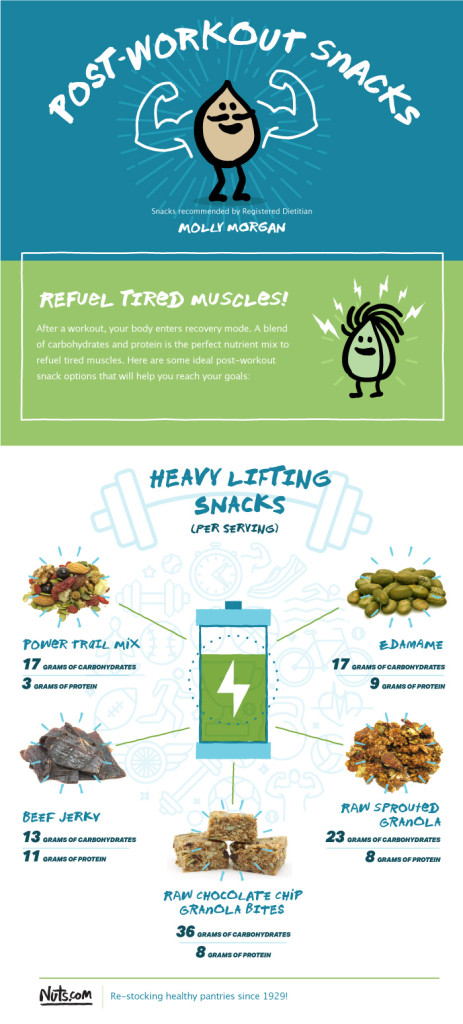
If you want to brush up on what your personal exercise nutrition should or could look like, contact a Registered Dietitian. We’re the trusted source for nutrition information. If you have a specific training need, let me know and I can connect you to a reputable colleague who knows the ins and outs of exercise nutrition!
Food photography and blog post written/captured by a talented student volunteer, Ceone Dyck. Ceone is a graduate of Human Nutritional Sciences. To learn more about Ceone click here or follow her on Facebook.
Please note this is not a sponsored post.
Don’t forget to follow Carrots and Cake on Instagram to see tiny square snap shots of my life.
– With Love, Carrots and Cake,

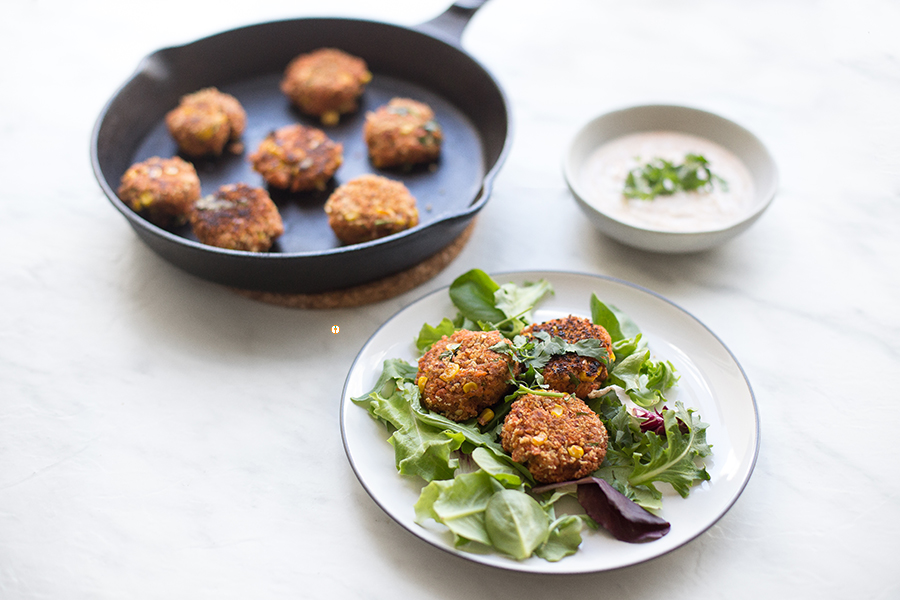 Hayyyyy friends. I’ve got another recipe to share with you today, this time, I wanted to focus on creating something that was budget friendly and easy to make. The result, tandoor spiced salmon cakes. The major protein in this recipe comes canned salmon which can typically range from $2.50 – $3.50 (Cdn) per can. A pretty sweet deal if you ask me!
Hayyyyy friends. I’ve got another recipe to share with you today, this time, I wanted to focus on creating something that was budget friendly and easy to make. The result, tandoor spiced salmon cakes. The major protein in this recipe comes canned salmon which can typically range from $2.50 – $3.50 (Cdn) per can. A pretty sweet deal if you ask me!
In our home, I’m the only fish eater. The hubs has made it loud and clear that he’s “allergic” (ahem, liar) to any form of seafood. Because of this, I tend not to splurge on seafood and often settle for canned varieties in single servings to help me meet my 2 servings of fish per week. Salmon also has a number of health benefits, here are only a few:
- it’s loaded with heart healthy omega-3 fatty acids
- excellent source of calcium (from the bones)
- it’s also one of the few foods that offer up vitamin D
- it’s super anti-inflammatory and therefore helps to protect the health of all the tiny cells that make up your body
The inspiration for these salmon cakes came from the Food Network. I knew immediately I wanted to add an Indian flair to their version so I set out for some Patak’s Tandoori Paste. This popular paste can be found at most grocery store retailers in the ethnic food aisle. A little bit of this paste goes a long way! I also added my favorite spices: garam masala, coriander and ground cumin.
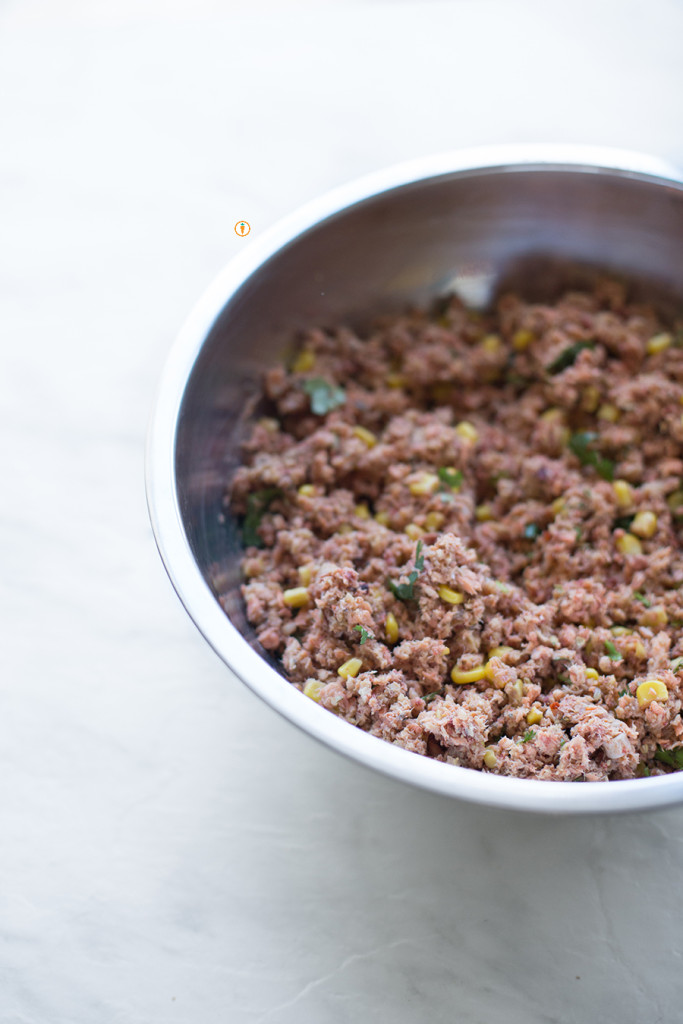
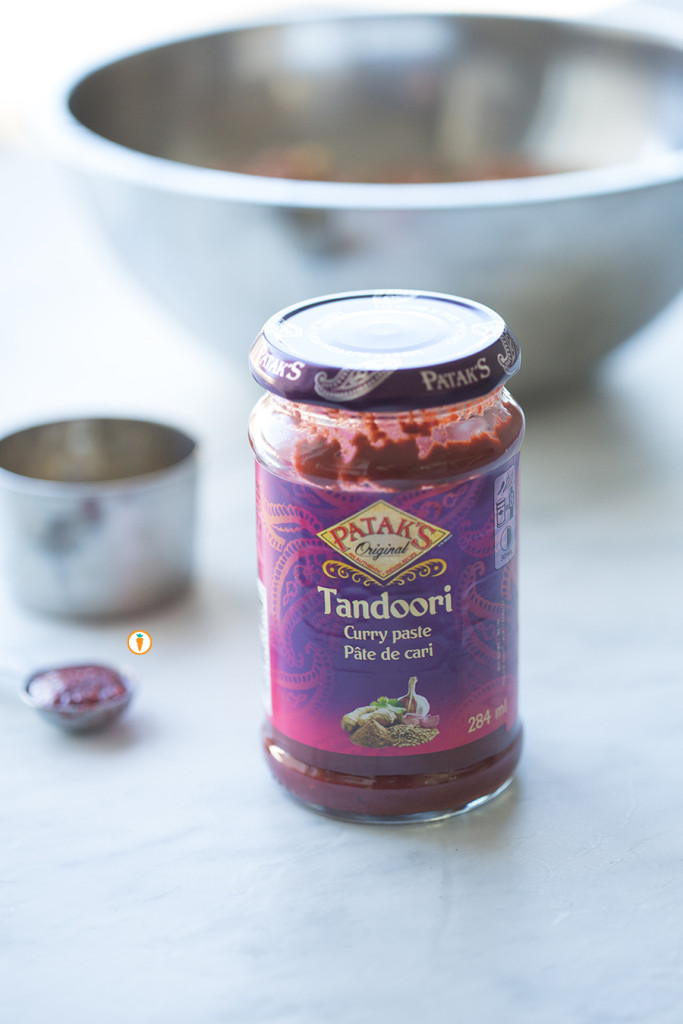
CAUTION: we learned a lot while developing this recipe. Keep these two pieces of advice in mind:
- DO NOT use the food processor, blender or beaters to create the mixture. Let me tell you, that’s a recipe for an epic fail!
- Make sure you thoroughly drain the liquid from the salmon cakes.
- 3 7.5 oz cans salmon, drained
- 1 cup frozen corn, thawed or canned corn
- 1 large egg
- ½ cup panko bread crumbs + ¼ cup panko bread crumbs in a shallow plate
- 2 Tbsp tandoori paste
- ¼ cup fresh cilantro, chopped
- 1 tsp ground cumin
- 1 tsp garam masala
- 1 tsp ground coriander
- Pinch of ground black pepper
- 3 Tbsp extra-virgin olive oil
- Place all ingredients (first ten) into a bowl. Mix together using a fork until all ingredients are combined.
- Shape into 2" or 3" patties and then press salmon cakes into the breadcrumbs, coating both sides well.
- Heat the olive oil in a large oven-safe nonstick skillet or cast iron pan over medium heat. Add the salmon cakes and cook until golden brown, 3 to 4 minutes per side.
- Transfer the skillet to the oven and bake until the cakes are heated through. About 5 - 8 minutes more.
Feel free to garnish your salmon cakes with some plain yogurt that has been spiced with salt, black pepper and some chilli powder. And of course, garnish with more fresh cilantro. These salmon cakes are great on a bed of greens, over a naan and I’ve also enjoyed gobbling it up solo.
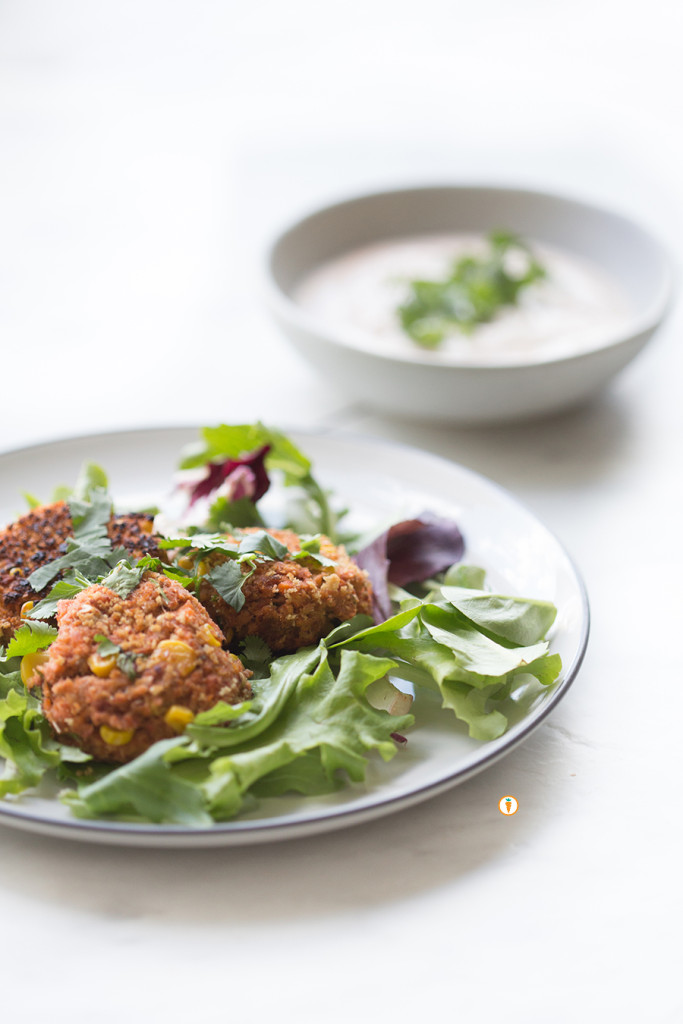
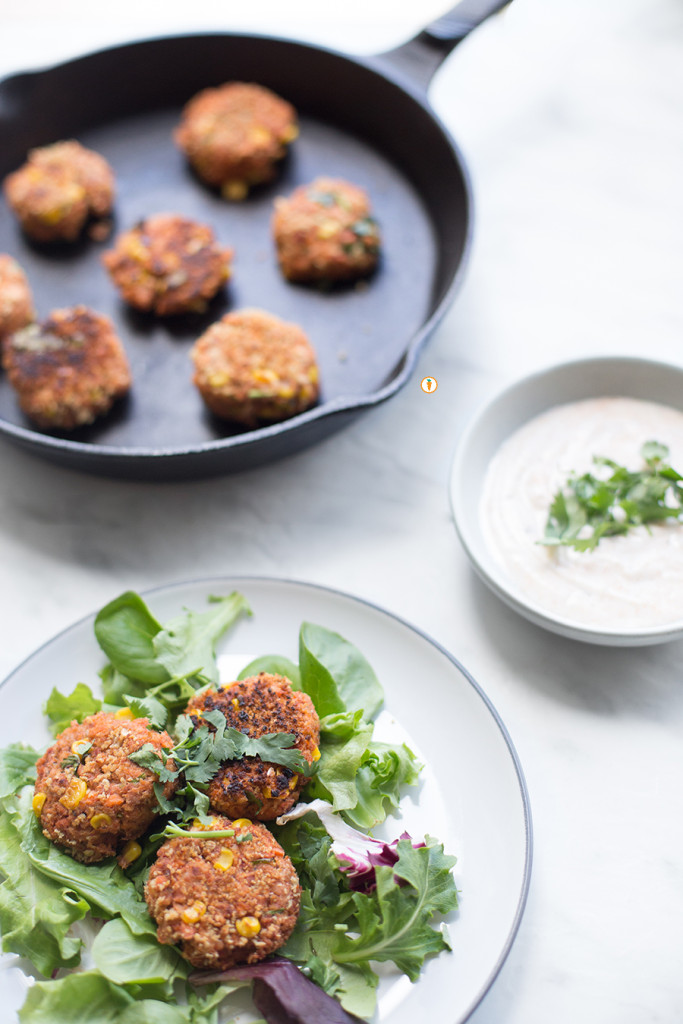 Food photography done by the talented Ceone Dyck. To learn more about Ceone click here or follow her on Facebook.
Food photography done by the talented Ceone Dyck. To learn more about Ceone click here or follow her on Facebook.
Don’t forget to follow Carrots and Cake on Instagram to see tiny square snap shots of my life.
– With Love, Carrots and Cake,

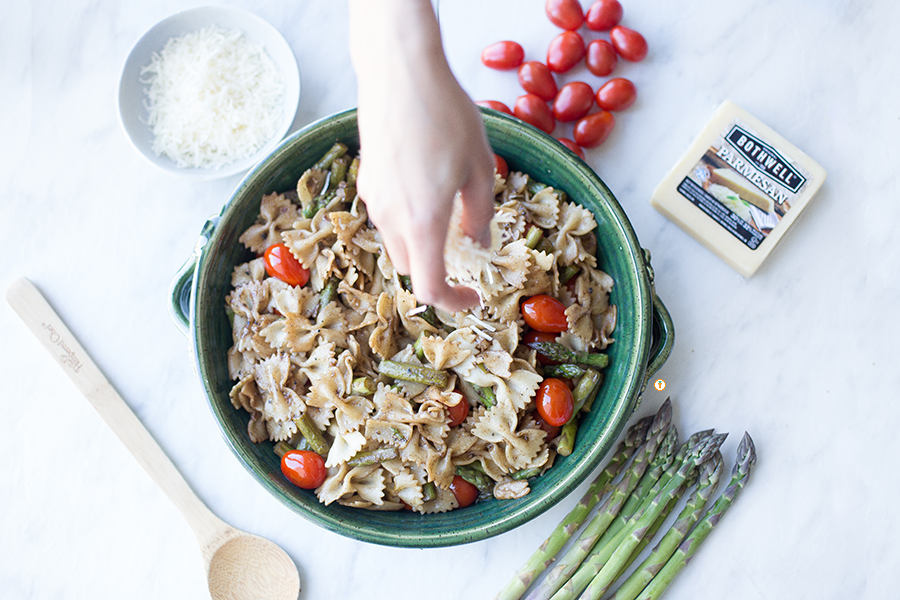 YAASSSS. Asparagus is finally in season. I remember being in my twenties and trying a spear of asparagus for the first time. I was confused. But then I had another spear. I was hooked. Since then, I’ve enjoy asparagus in many ways from grilling, steaming, wrapped in prosciutto and mixed into a summery pasta dish!
YAASSSS. Asparagus is finally in season. I remember being in my twenties and trying a spear of asparagus for the first time. I was confused. But then I had another spear. I was hooked. Since then, I’ve enjoy asparagus in many ways from grilling, steaming, wrapped in prosciutto and mixed into a summery pasta dish!
This pasta recipe is SO EASY to throw together on a busy weeknight. Washing and trimming the asparagus ahead of time will help make this a total breeze. Besides, doesn’t everyone love pasta?
Here are a few reasons why you’ll enjoy this recipe and feel good about eating it:
- It’s colourful – beautiful red and green colors make this pretty on the eye
- The whole wheat pasta will keep you full
- You can top your pasta with any cheese you desire, I used Bothwell Cheese Parmesan but it’s also taste with goat cheese and feta cheese; if you’re vegan you can nix the cheese or use your favorite dairy-free product!
- It includes 9 only ingredients! NINE!
- The olive oil is super heart health and anti-inflammatory (remember, we talked about that here)
Kay…one more picture, and then I’ll share the recipe!
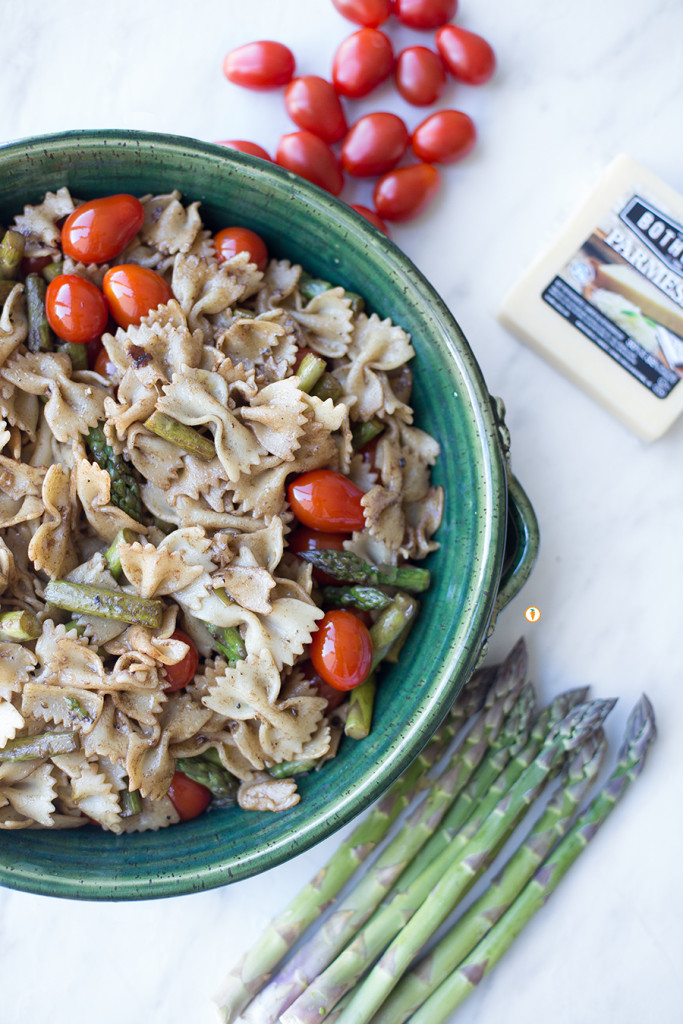
- 2 cups whole wheat pasta (uncooked)
- approx 20 spears of asparagus, washed, trimmed and cut into 1 inch pieces
- 1 cup cherry tomatoes, halved
- 2 cloves garlic
- ¼ cup and 1 tbsp olive oil
- ¼ cup balsamic vinegar
- Salt and pepper, to taste
- ⅓ cup cheese (parmesan, goat cheese or feta cheese)
- Cook pasta according to package directions. Drain and set aside.
- Meanwhile, sauté asparagus in 1 tbsp olive oil over medium heat. Continue to cook asparagus until it is tender.
- Add in garlic, cooked pasta, remaining olive oil, balsamic vinegar, salt and pepper. Mix together and heat through for about one minute to allow the garlic to infuse itself into the dish.
- Add in cherry tomatoes and continue to heat the pasta through for 5 minutes or until cherry tomatoes begin to wilt.
- Remove from heat. Top with cheese.
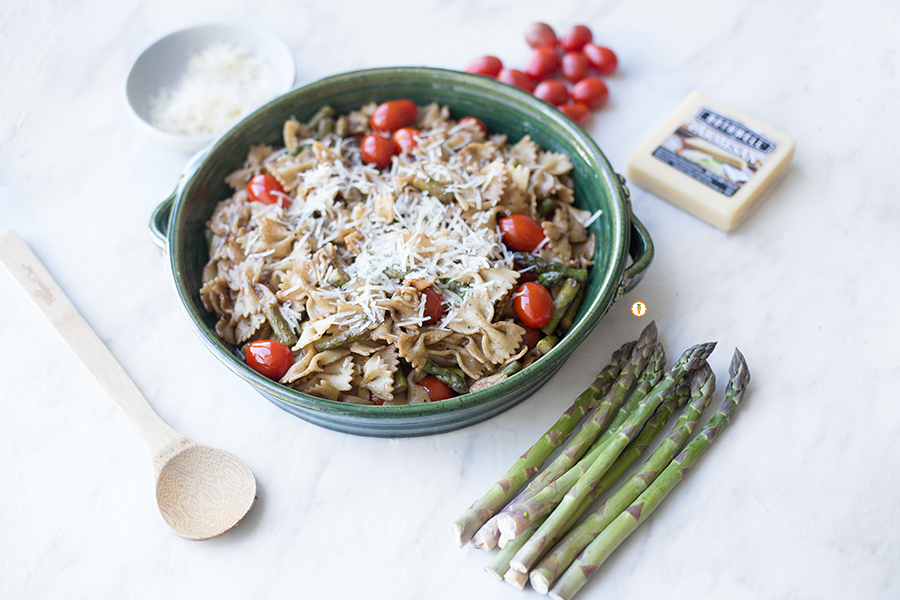 Food photography done by the talented Ceone Dyck. To learn more about Ceone click here or follow her on Facebook.
Food photography done by the talented Ceone Dyck. To learn more about Ceone click here or follow her on Facebook.
Don’t forget to follow Carrots and Cake on Instagram to see tiny square snap shots of my life.
– With Love, Carrots and Cake,

